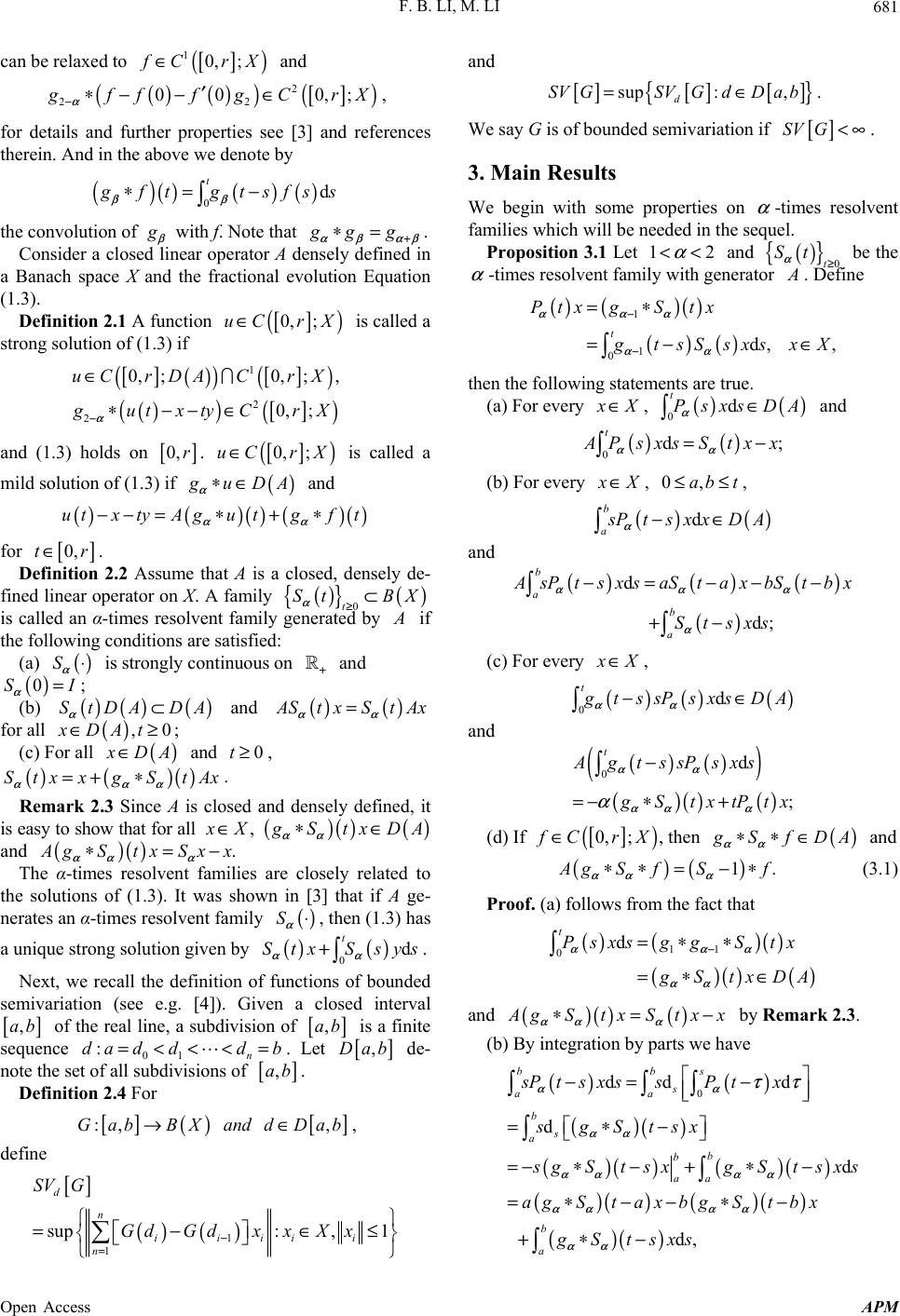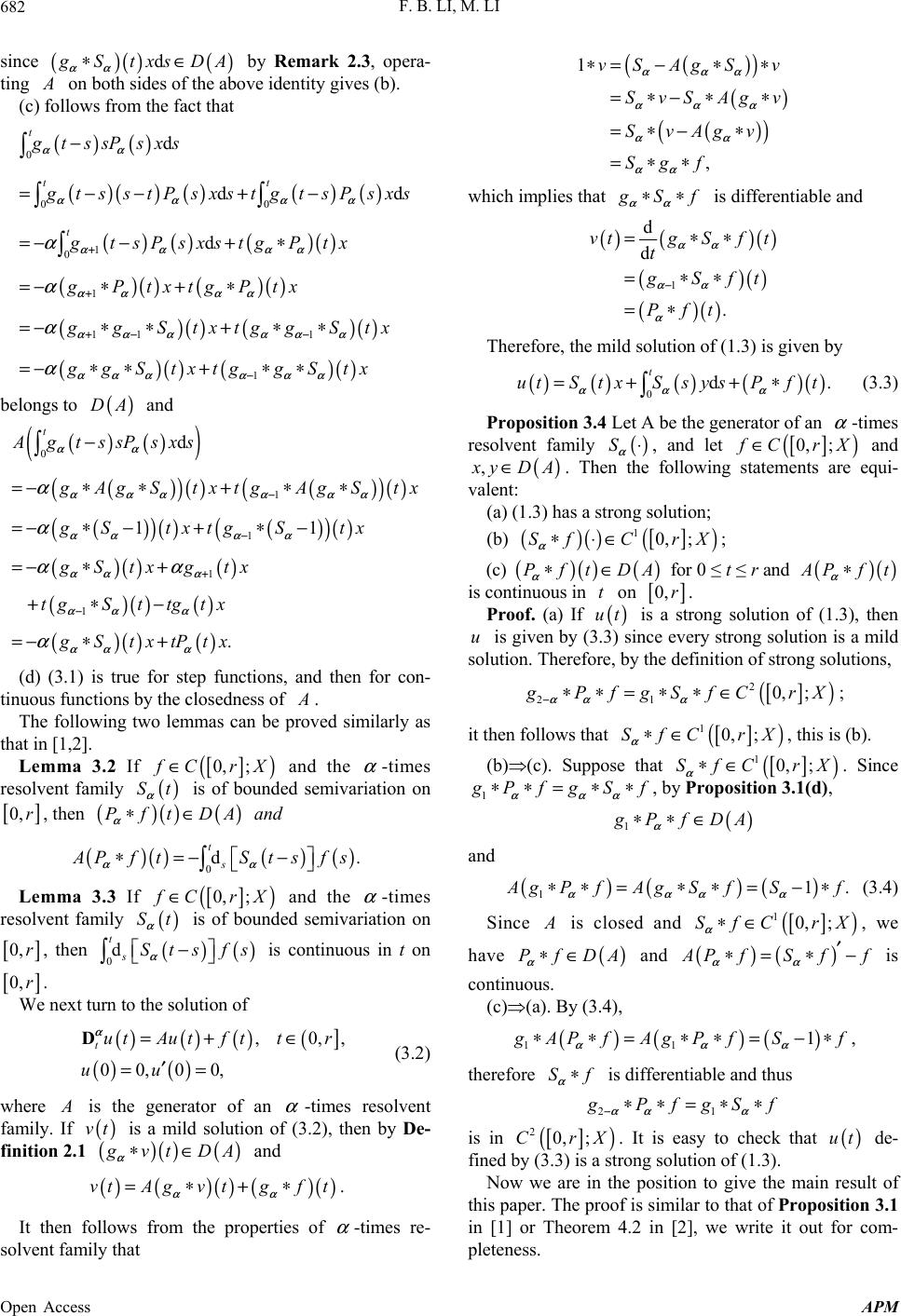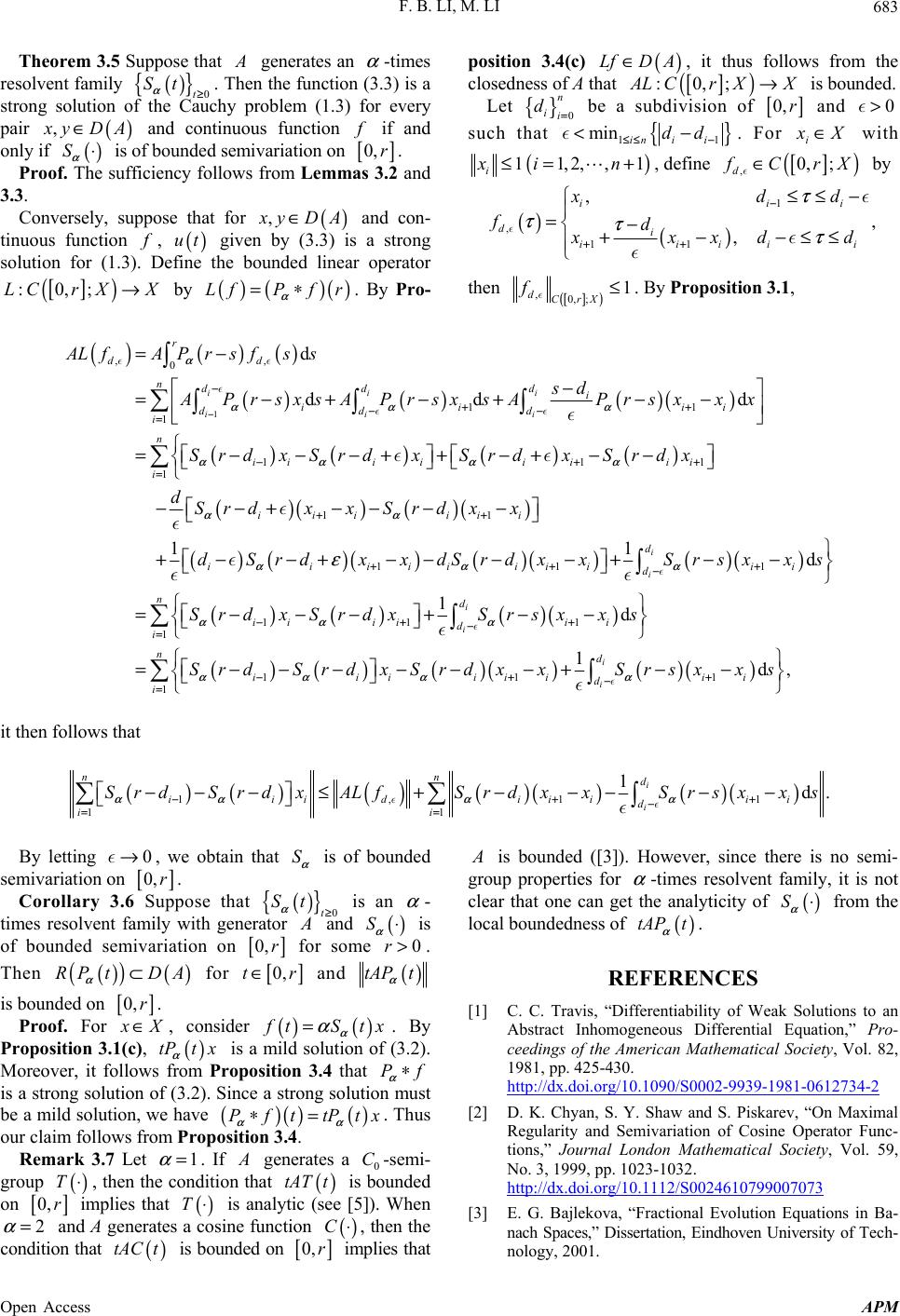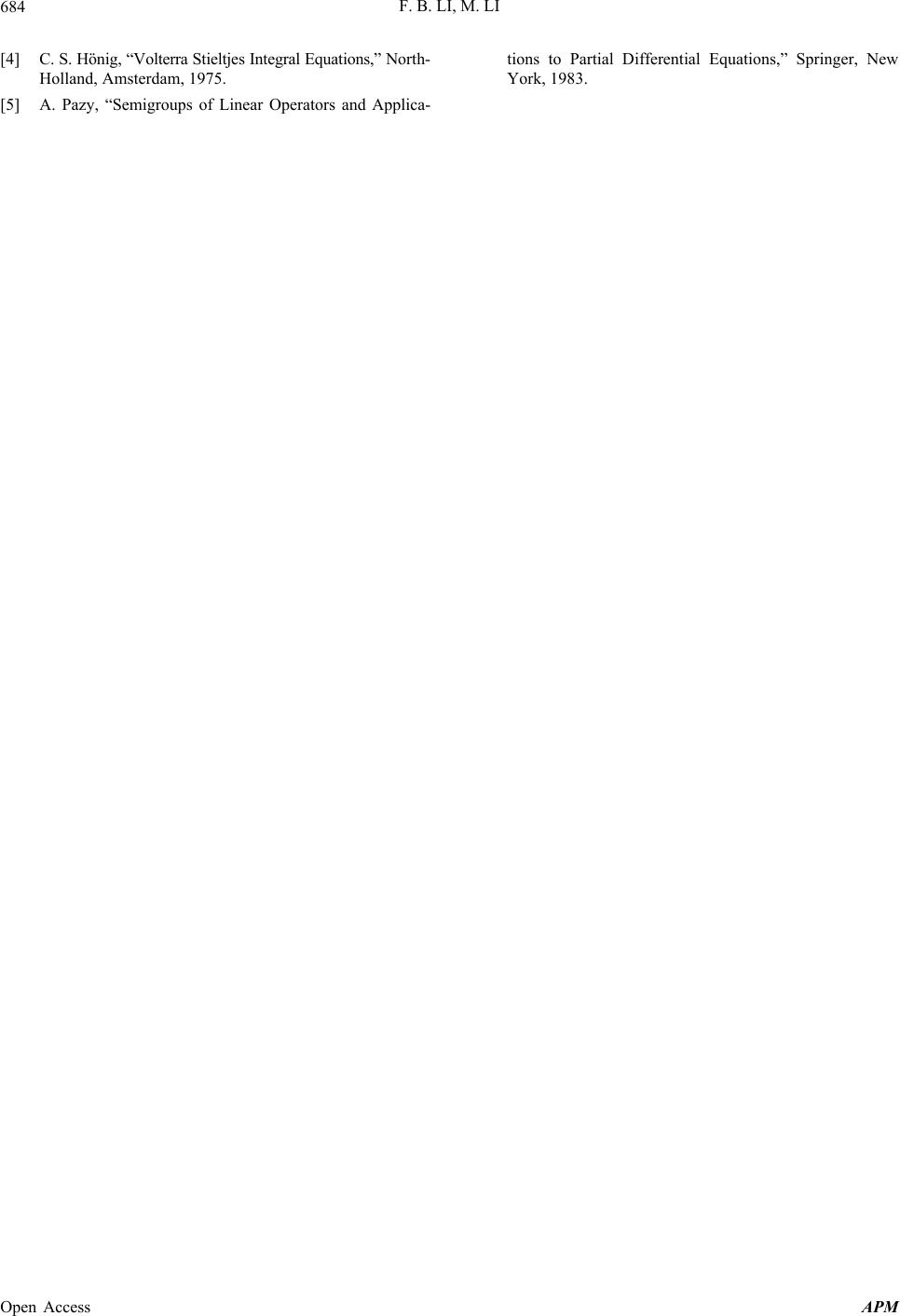 Advances in Pure Mathematics, 2013, 3, 680-684 Published Online November 2013 (http://www.scirp.org/journal/apm) http://dx.doi.org/10.4236/apm.2013.38091 Open Access APM On Maximal Regularity and Semivariation of α-Times Resolvent Families* Fubo Li, Miao Li Department of Mathematics, Sichuan University, Chengdu, China Email: lifubo@scu.edu.cn, mli@scu.edu.cn Received October 15, 2013; revised November 15, 2013; accepted November 21, 2013 Copyright © 2013 Fubo Li, Miao Li. This is an open access article distributed under the Creative Commons Attribution License, which permits unrestricted use, distribution, and reproduction in any medium, provided the original work is properly cited. ABSTRACT Let and A be the generator of an -times resolvent family 1 α <<2 α () 0t St α ≥ on a Banach space X. It is shown that the fractional Cauchy problem , ()() () tutAutf t α =+D ( 0,tr∈; has maximal regularity on () ( 0,uu ′ )( ) 0DA∈ ( 0, ;Cr ) X if and only if is of bounded semivariation on () ⋅S α 0, r. Keywords: -Times Resolvent Family; Maximal Regularity; Semivariation α 1. Introduction Many initial and boundary value problems can be re- duced to an abstract Cauchy problem of the form ()() () ()( ) ,0, 0 utAutft tr uxDA ′=+ ∈ =∈ (1.1) where A is the generator of a C0-semigroup. One says that (1.1) has maximal regularity on ( 0, ;CrX ) if for every ( 0, ; ) CrX∈ there exists a unique ( 10,;rX ) uC∈ satisfying (1.1). From the closed graph theorem it follows easily that if there is maximal regularity on () 0, ;CrX, then there exists a constant C > 0 such that [] () [] () [] () 0, ;0, ;0, ;. CrXCrX CrX uAuf ′+≤ Travis [1] proved that the maximal regularity is equi- valent to the 0-semigroup generated by C being of bounded semivariation on 0, r. Chyan, Shaw and Piskarev [2] gave similar results for second order Cauchy problems. More precisely, they showed that the second order Cauchy problem ()() ()( ()()( ) ,0, 0,0,, utAutfttr uxu yxyD ′′ =+ ∈ ′ ==∈A (1.2) has maximal regularity on 0, r if and only if the cosine opeator function generated by A is of bounded semivaria- tion on 0, r. In this paper, we will consider the maximal regularity for fractional Cauchy problem ()() ()( ()()( ) ,0, 0,0,, utAutf ttr uxu yxyD α =+ ∈ ′ ==∈ t D 1, α ∈ A (1.3) where , () 2 is the generator of an -times resolvent family (see Definition 2.2) and t is under- stood in the Caputo sense. We show that (1.3) has ma- ximal regularity on α u α D ( 0, ;CrX ) if and only if the corresponding -times resolvent family is of bounded semivariation on α 0, r. 2. Preliminaries Let , 12 α << () () 0: t δ =t and () () () 1 :0 t gt β β β β − => Γ for . Recall the Caputo fractional derivative of order 0 0 α > () t> ( )() [] 2 22 0 d :d d t t ,0,tgtsfsstr s α − =− ∈ D α for ( ; ) 20, CrX∈. The condition that *The authors are partially supported by the NSFC of China (Grant No. 11371263), and the second author is also supported by Program for ew Century Excellent Talents in University of China. () 20, ; CrX∈  F. B. LI, M. LI 681 can be relaxed to () 10, ; CrX∈ and () () () () 2 22 00 0,; fffgCrX α −′ ∗− −∈, for details and further properties see [3] and references therein. And in the above we denote by () ()()() 0d t ft gtsfss ββ ∗= − the convolution of with f. Note that gg g α α + ∗= . Consider a closed linear operator A densely defined in a Banach space X and the fractional evolution Equation (1.3). Definition 2.1 A function ( 0, ;uC rX∈ ) is called a strong solution of (1.3) if () () () () () [] () 1 2 2 0, ;0, ;, 0, ; uCrDACrX gutxtyCrX α − ∈ ∗−−∈ and (1.3) holds on 0, r. ( 0, ;uC rX∈ ) is called a mild solution of (1.3) if () uDA α ∗∈ and () () () () () utx tyAgu tgft αα −− =∗+∗ for 0,tr∈. Definition 2.2 Assume that A is a closed, densely de- fined linear operator on X. A family () () St BX α ⊂ 0t≥ is called an α-times resolvent family generated by if the following conditions are satisfied: (a) is strongly continuous on and ; () S α ⋅ SI= ( S t + () () 0 α (b) and ) ()() DA DA α ⊂ () StxStAx αα = for all () ,0 DA t∈≥ () ; (c) For all DA∈ and , 0t≥ x () ) () Stxx tA ααα =+ ( g S∗. Remark 2.3 Since A is closed and densely defined, it is easy to show that for all X∈, () ()( ) StxDA αα ∗∈ and () () . gStxS∗=xx− αα α The α-times resolvent families are closely related to the solutions of (1.3). It was shown in [3] that if A ge- nerates an α-times resolvent family , then (1.3) has () S α ⋅ a unique strong solution given by . ()( ) 0d t Stx Ssys αα + Next, we recall the definition of functions of bounded semivariation (see e.g. [4]). Given a closed interval ,ab of the real line, a subdivision of ,ab is a finite sequence 01. Let :n dadd db=<<< = ,Dab de- note the set of all subdivisions of ,ab . Definition 2. 4 For () :,GabBX→ and ,dDab∈, define ()( ) 1 1 sup:, 1 d n iiiii n SV G GdGdxxXx − = =−∈ and sup: , d SVGSVGdDa b=∈ . We say G is of bounded semivariation if SV G<∞. 3. Main Results We begin with some properties on -times resolvent families which will be needed in the sequel. α Proposition 3.1 Let and 1 α <<2 () 0t≥ be the -times resolvent family with generator St α α . Define () () () ()() 1 1 0d, , t PtxgS tx tsSsxs xX ααα αα − − =∗ =− ∈ then the following statements are true. X∈, and ()() 0d tPsxs DA α ∈ ()() t (a) For every 0d; PsxsS txx=− αα (b) For every X∈, , 0,ab t≤≤ () ( d b a ) Pt sxxDA α −∈ and ()()() () d d; b a b a sPtsx saStaxbStbx Stsxs ααα α −=−−− +− (c) For every X∈, ()() ( 0d t ) tssPsxsDA αα −∈ and ()() () () () () 0d ; t AgtssPsxs StxtPtx αα αα α α − =− ∗+ (d) If () 0, ; CrX∈, then () SfDA αα ∗∗∈ () and () 1. gS fSf αα α ∗∗ =−∗ (3.1) Proof. (a) follows from the fact that () () () () ()() 11 0d tPsxsg gStx StxDA ααα αα − =∗ ∗ =∗ ∈ and () () () gStxStxx αα α ∗=− by Remark 2.3. (b) By integration by parts we have () () () () () () () () () () () () () () 0 dd d d d d, bbs s aa b s a b b aa b a sPtsx ssPtx sgStsx gStsx gStsxs ag Staxbg Stbx gStsxs αα αα αα αα αα αα αα ττ −= − =∗− =−∗ −+∗ − =∗−−∗− +∗− ≤ Open Access APM  F. B. LI, M. LI 682 since () ()() d StxsDA αα ∗∈ by Remark 2.3, opera- ting on both sides of the above identity gives (b). (c) follows from the fact that ()() ()()() ()() ()() () () () () () () () () () () () () () () 0 00 1 0 1 11 1 1 d d d t tt t gtssPsxs d tsstPsxstgtsPsxs gtsPsxstgPtx gP txtgPtx g Stxtgg Stx ggStxtg gStx αα αααα αα αα αα αα ααα ααα αααα αα α α α α + + +− − − − =−−+ − =−−+ ∗ =−∗+ ∗ =−∗ ∗+∗ ∗ =−∗∗+∗ ∗ belongs to and () DA ()() () () () () () ( () () () () () () () () () () () () () () () () 0 1 1 1 1 d 11 . t AgtssPsxs ) Ag StxtgAg Stx gStxtg Stx gStx gtx tgSttgtx gStxtPtx αα αααα αα αααα αα α αα α αα α α α αα α − − + − − =−∗∗+∗ ∗ =−∗−+∗ − =− ∗+ +∗− =− ∗+ (d) (3.1) is true for step functions, and then for con- tinuous functions by the closedness of . The following two lemmas can be proved similarly as that in [1,2]. Lemma 3.2 If ( 0, ; ) CrX∈ () St α and the -times resolvent family is of bounded semivariation on α 0, r, then and () ()( ) t DA∗∈Pf α () ()()( ) 0d t s. Pft Stsfs αα ∗=− − Lemma 3.3 If ( 0, ; ) CrX∈ () St α and the -times resolvent family is of bounded semivariation on α 0, r, then is continuous in t on ()( 0d t sSts fs α − ) 0, r. We next turn to the solution of ()() ()( () () ,0, 00,00, tutAutf ttr uu α =+ ∈ ′ == D, (3.2) where is the generator of an -times resolvent family. If is a mild solution of (3.2), then by De- finition 2.1 α () vt () ()( ) vt DA∗∈ α and () () () () () vtAgvtgft αα =∗+∗. It then follows from the properties of -times re- solvent family that α () () () () () 1 , vSAgSv SvSAgv SvAgv Sg f ααα ααα αα αα ∗= −∗∗ =∗−∗∗ =∗−∗ =∗∗ which implies that Sf αα ∗∗ is differentiable and () () () () () () () 1 d d . vtgSf t t Sft Pft αα αα α − =∗∗ =∗∗ =∗ Therefore, the mild solution of (1.3) is given by ()()( ) () () 0d. t utS txSsysPft αα α =+ +∗ (3.3) Proposition 3.4 Let A be the generator of an -times resolvent family , and let () S α ⋅ () ;0, CrX∈ and () , yDA∈. Then the following statements are equi- valent: (a) (1.3) has a strong solution; (b) () () () 10,;SfC rX α ∗⋅∈ ; (c) for 0 ≤ t ≤ r and () ()( ) Pft DA α ∗∈ () () Pft α ∗ is continuous in on t 0, () ut r. Proof. (a) If is a strong solution of (1.3), then is given by (3.3) since every strong solution is a mild solution. Therefore, by the definition of strong solutions, u () 2 21 0, ; PfgSfCrX αα α −∗∗=∗∗∈ ; it then follows that ( 10,;SfC rX α ∗∈ ) , this is (b). (b)(c). Suppose that ( 0, ;SfC rX α ∗∈ ) 1. Since 1 PfgS f ααα ∗∗=∗∗, by Proposition 3.1(d), () 1 PfDA α ∗∗∈ and ()( )() 11. gP fAgSfSf αααα ∗∗ =∗∗ =−∗ (3.4) Since is closed and ( 10, ;SfC rX α ∗∈ ) , we have and () PfDA α ∗∈ ()() PfS ff αα ∗= ∗ − ′ is continuous. (c)(a). By (3.4), ()( )() 11 1 APfAgPfSf ααα ∗∗=∗∗=−∗, therefore is differentiable and thus Sf α ∗ 21 PfgS f αα α −∗∗=∗∗ is in ( 20, ;CrX ) . It is easy to check that de- fined by (3.3) is a strong solution of (1.3). () ut Now we are in the position to give the main result of this paper. The proof is similar to that of Proposition 3.1 in [1] or Theorem 4.2 in [2], we write it out for com- pleteness. Open Access APM  F. B. LI, M. LI Open Access APM 683 position 3.4(c) , it thus follows from the closedness of A that () LfD A∈ () :0,; LCr XX→ is bounded. Theorem 3.5 Suppose that generates an -times resolvent family () 0t≥. Then the function (3.3) is a strong solution of the Cauchy problem (1.3) for every pair St α )( , yD∈A and continuous function if and only if is of bounded semivariation on () S α ⋅ 0, r. Let be a subdivision of {} 0 n ii d= 0, r and 0> such that 11 min in ii dd ≤≤ − <−. For with X i∈x () 11,2,,1 i xi n≤= +, define () ,0,; d CrX∈ by Proof. The sufficiency follows from Lemmas 3.2 and 3.3. () () 1 , 11 , , , ii di iiii xd fd i i d xx dd τ τττ − ++ ≤≤ − =− +−−≤≤ Conversely, suppose that for () , yDA∈ and con- tinuous function , given by (3.3) is a strong solution for (1.3). Define the bounded linear operator () ut () :0,;LCr XX→ by . By Pro- () () () LfPf r α =∗ then [] () ,0,;1 dCrX f≤ . By Proposition 3.1, () ()() () ()() () ()()() () ()()()() 1 ,, 0 11 1 11 1 11 d dd d ii i ii i r dd ndd d i ii ii dd d i n iii ii iii i iii iii AL fA Prs fss sd APrsxsAPrsx sAPrsxx x Srdx SrdxSrdxSrdx dSrdxxSrd xx α αα α αααα αα − − ++ −− = −+ = ++ =− − =−+−+ −− =−−−++−+−− −−+−−−− 1 + ()()() ()() () () ()() () () ()()()() () () 11 11 1 1 111 1 11 d 1d 1d i i i i i i d iiiiiiiiii d nd iiiii i d i nd iiiiiiii d i dSrdx xdSrdx xSrsx xs Srdx SrdxSrsxxs SrdSrdxSrdxxSrsx xs αα α αα α αα αα ε ++ − −+ + − = −++ − = +−−+−−−−+−− =−−−+−− =−−− −−−+−− , 1+ it then follows that ()() () ()() () () 1,1 11 1d. i i nn d iiid iiii d ii SrdSrdxALfSrdx xSrsx xs ααα α −++ − == −− −≤+−−−−− 1 i By letting , we obtain that is of bounded semivariation on 0→S α 0, r. () Corollary 3.6 Suppose that 0t α ≥ is an - times resolvent family with generator St α and is of bounded semivariation on () S α ⋅ 0, r for some . 0>r Then for () () () RP tDA α ⊂ 0,tr∈ () tAPt and α is bounded on 0, r Xx ∈ . Proof. For , consider () () tSt α α = () ()() Pft tPtx αα ∗= x. By Proposition 3.1(c), is a mild solution of (3.2). Moreover, it follows from Proposition 3.4 that is a strong solution of (3.2). Since a strong solution must be a mild solution, we have . Thus our claim follows from Proposition 3.4. () t x α tP Pf α ∗ Remark 3.7 Let . If 1 α = generates a 0 C-semi- group , then the condition that is bounded on () T⋅ () tAT t 0, 2= r implies that is analytic (see [5]). When and A generates a cosine function , then the condition that is bounded on () T⋅ () t α ( ⋅ ) C tAC 0, r implies that is bounded ([3]). However, since there is no semi- group properties for -times resolvent family, it is not clear that one can get the analyticity of from the local boundedness of . () S α ⋅ () t α tAP REFERENCES [1] C. C. Travis, “Differentiability of Weak Solutions to an Abstract Inhomogeneous Differential Equation,” Pro- ceedings of the American Mathematical Society, Vol. 82, 1981, pp. 425-430. http://dx.doi.org/10.1090/S0002-9939-1981-0612734-2 [2] D. K. Chyan, S. Y. Shaw and S. Piskarev, “On Maximal Regularity and Semivariation of Cosine Operator Func- tions,” Journal London Mathematical Society, Vol. 59, No. 3, 1999, pp. 1023-1032. http://dx.doi.org/10.1112/S0024610799007073 [3] E. G. Bajlekova, “Fractional Evolution Equations in Ba- nach Spaces,” Dissertation, Eindhoven University of Tech- nology, 2001.  F. B. LI, M. LI 684 [4] C. S. Hönig, “Volterra Stieltjes Integral Equations,” North- Holland, Amsterdam, 1975. [5] A. Pazy, “Semigroups of Linear Operators and Applica- tions to Partial Differential Equations,” Springer, New York, 1983. Open Access APM
|